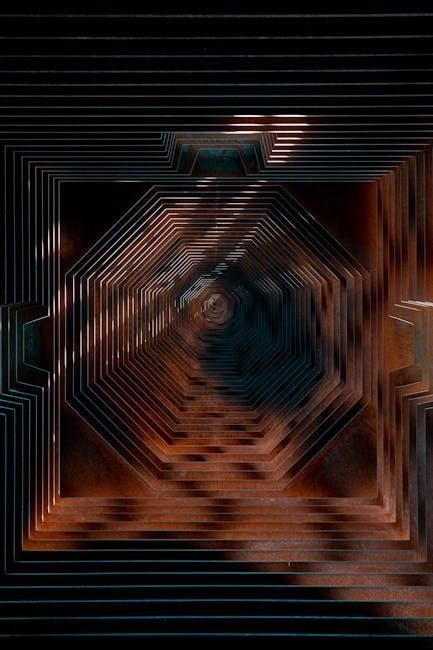3D Dragon Illusion PDF: Unveiling the Magic
Embark on a mesmerizing journey into the world of optical illusions with the 3D Dragon Illusion PDF! Discover the secrets behind this captivating phenomenon, where a simple paper craft appears to follow your gaze, defying reality.
Prepare to be amazed by the 3D Dragon Illusion, a remarkable paper craft that creates a captivating optical effect. This illusion plays tricks on your perception, making a seemingly flat dragon appear to have a three-dimensional head that follows your gaze as you move. Inspired by the ingenuity of Jerry Andrus and popularized by Binary Arts, this project is a delightful blend of art, science, and a touch of magic. The illusion is easily accessible through a downloadable PDF template, allowing anyone to construct their own mesmerizing dragon. Prepare for an engaging experience that challenges your understanding of perspective.
The Science Behind the Illusion: Perspective and Binocular Vision
The 3D Dragon Illusion masterfully exploits the principles of perspective and binocular vision to trick our brains. The dragon’s hollow face is perceived as a normal, convex face due to our ingrained assumptions about facial structures. This is a clever manipulation of perspective. Furthermore, the illusion is enhanced by binocular vision; however, it works even better when one eye is closed. By viewing the dragon with one eye, the depth cues become ambiguous, making the head appear to move and follow you. This interplay of visual cues results in the compelling illusion of a three-dimensional, gaze-tracking dragon.
Materials Needed to Create the 3D Dragon
To embark on your journey of creating the 3D Dragon Illusion, gather these essential materials. First, you’ll need the printed dragon template, readily available as a PDF download. Opt for heavy stock paper to ensure durability and a professional finish for your dragon. Arm yourself with precise cutting tools such as scissors or an X-Acto knife, and remember to use a cutting mat for safety if you choose the latter. Finally, secure the dragon’s form with adhesive – either tape or glue will suffice, depending on your preference and desired level of permanence.
Template: Downloading and Printing
The first step in bringing your 3D Dragon Illusion to life is acquiring the template. Easily found online as a PDF file, simply search for “3D Dragon Illusion Print Out PDF” to access numerous options. Once you’ve located a suitable template, download it to your computer. Next, prepare your printer and load it with the chosen paper stock. Ensure your printer settings are configured for optimal print quality to capture the intricate details of the dragon design. Finally, print the template, and you’re ready to move on to the next stage of the assembly process.
Paper: Choosing the Right Stock
Selecting the appropriate paper is crucial for the 3D Dragon Illusion. Heavy stock paper, such as cardstock, is highly recommended for its durability and ability to hold its shape during folding. This ensures that the dragon maintains its structural integrity and enhances the illusion’s effect. Avoid using thin or flimsy paper, as it may tear easily or not provide enough support for the intricate folds. Consider the paper’s color as well; while white paper is a standard choice, colored paper can add a unique aesthetic to your dragon.
Tools: Scissors or X-Acto Knife
Accurate cutting is paramount for the 3D Dragon Illusion’s success. Scissors are a reliable option for general cutting, particularly for those less experienced with precision tools. For intricate details and clean lines, an X-Acto knife is highly recommended. When using an X-Acto knife, always employ a cutting mat to protect your work surface and ensure safety. Exercise caution and maintain a steady hand, carefully following the template’s lines; A dull blade can lead to ragged edges, so replace the blade regularly to achieve optimal results.
Adhesive: Tape or Glue
Securing the dragon’s tabs requires a reliable adhesive. Tape offers a quick and clean option, ideal for beginners. Double-sided tape provides a seamless finish, concealing the adhesive. Glue, on the other hand, offers a more permanent bond, ensuring the dragon’s longevity. A glue stick is less messy than liquid glue, preventing unwanted drips. Apply adhesive sparingly to avoid warping the paper. Allow glue to dry completely before handling the dragon. Consider the drying time and bonding strength when selecting your adhesive for optimal results and a sturdy final product.
Step-by-Step Assembly Instructions
Constructing your 3D dragon involves a precise sequence of steps. Begin by carefully cutting out the template pieces, following the solid lines; Next, pre-fold along all the dotted lines to ensure crisp edges. Proceed by gently shaping the head and body, creating the illusion’s depth. Apply adhesive to the designated tabs, one at a time. Carefully align and secure each tab to its corresponding section. Pay close attention to the template’s instructions for proper alignment. Allow sufficient drying time for the adhesive to set firmly. Finally, inspect your dragon for any loose tabs or imperfections, reinforcing as needed.
Cutting Out the Template
Precision is key when cutting out the 3D dragon template. Use sharp scissors or an X-Acto knife for clean, accurate cuts. A cutting mat is highly recommended if using a knife, protecting your work surface. Begin with the outer edges, carefully following the solid lines. Pay close attention to intricate details, such as the dragon’s features and tabs. Avoid rushing; slow, deliberate cuts will yield the best results. For smaller, more complex areas, consider using a smaller pair of scissors or the tip of the X-Acto knife. Discard any excess paper, leaving only the essential template pieces. A well-cut template is crucial for a successful illusion.
Folding the Dragon
Folding is a critical step in bringing the 3D dragon illusion to life. Refer to the template’s instructions for precise fold lines, typically indicated by dotted or dashed lines. Crease each fold sharply and accurately. Begin with the larger folds, gradually working your way to the smaller, more intricate ones. A ruler or straight edge can assist in creating clean, crisp folds. Ensure that each fold is in the correct direction – either a valley fold (folding inward) or a mountain fold (folding outward). Take your time and double-check each fold before moving on to the next. Accurate folding is essential for the illusion to work effectively.

Securing the Tabs
Once the dragon is folded, the next crucial step involves securing the tabs to maintain its shape and create the illusion. Apply a small amount of adhesive, either tape or glue, to each tab. Carefully align the tab with the corresponding surface on the dragon model, ensuring a snug fit. Avoid using excessive adhesive, as it can cause the paper to warp or become messy. Press firmly on the tab for a few seconds to allow the adhesive to bond properly. Double-check that all tabs are securely fastened, as this will ensure the dragon maintains its hollow-faced structure, essential for the illusion to work its magic.
How to Experience the Illusion
To fully appreciate the 3D Dragon Illusion, begin by positioning the assembled dragon at eye level. Ensure there’s adequate lighting in the room. Now, the key is to close or cover one eye; this enhances the depth perception trick. As you slowly move from side to side, observe the dragon’s head. You’ll notice that it appears to follow your movement, seemingly turning its head to maintain eye contact. Experiment with different distances and angles to maximize the effect. Remember, the illusion relies on your brain interpreting the hollow face as a protruding one, creating the captivating 3D effect.
Positioning and Viewing
Optimal viewing of the 3D Dragon Illusion hinges on careful positioning. Place the assembled dragon on a stable surface at approximately eye level. The ambient lighting should be consistent and not too dim, as shadows can distort the effect. Stand a few feet away from the dragon, ensuring you can clearly see both of its eyes. Experiment with the angle; a slight downward tilt can sometimes enhance the illusion. Focus your gaze on the dragon’s head, particularly its eyes. Subtle adjustments to your position and the dragon’s angle will unlock the full potential of this mind-bending optical trick.
The One-Eye Trick
To truly experience the magic of the 3D Dragon Illusion, employ the “one-eye trick.” Close or cover one of your eyes while observing the dragon. This eliminates binocular vision, which normally provides depth perception. By relying solely on monocular vision, your brain interprets the concave face of the dragon as convex, creating the illusion that it’s turning its head to follow you. This effect is amplified because the brain is hardwired to recognize faces and make assumptions about their shape. Experiment with both eyes to see which provides a stronger illusion for you.
Moving the Dragon for the Effect
Once assembled, the 3D Dragon Illusion truly comes alive when you introduce movement. Hold the dragon so that you can clearly see both of its eyes. Now, gently move the dragon from side to side, or walk around it while keeping your gaze fixed on its face. As you move, the dragon’s head will appear to turn, seemingly following your movements. This is due to the way your brain interprets the distorted perspective of the dragon’s hollow face. The illusion is most convincing when viewed with one eye closed.
Educational Applications of the 3D Dragon Illusion
The 3D Dragon Illusion isn’t just a fun trick; it’s a valuable educational tool. It can be used in art, science, and math classrooms to teach about perspective, optical illusions, and three-dimensional shapes. Students can learn about how their brains process visual information and how illusions can trick their perception. The hands-on nature of the project makes learning engaging and memorable. By creating and experimenting with the dragon, students can gain a deeper understanding of these concepts in a fun and interactive way, fostering critical thinking and problem-solving skills.
Art, Science, and Math Classrooms
The 3D Dragon Illusion offers unique interdisciplinary applications across art, science, and math. In art, it demonstrates principles of perspective and visual deception. Science classes can explore binocular vision and how the brain interprets images. Math lessons can delve into the geometry of 3D shapes and spatial reasoning. This project encourages hands-on learning, allowing students to create a tangible model that illustrates complex concepts. By integrating the dragon illusion into diverse subjects, educators can foster a deeper understanding of these principles and stimulate students’ curiosity in a fun and engaging way.

Learning About Perspective and 3D Shapes

The 3D Dragon Illusion is an excellent tool for learning about perspective and three-dimensional shapes. By constructing the dragon, individuals gain a hands-on understanding of how perspective tricks the eye into perceiving depth on a flat surface. The illusion highlights the difference between 2D representations and 3D reality, enhancing spatial reasoning skills. Students can explore how manipulating angles and lines creates the illusion of a hollow face that appears to follow the viewer. This activity fosters critical thinking and encourages a deeper appreciation for the principles of visual perception and geometric forms.
The History and Inspiration Behind the Illusion (Jerry Andrus & Binary Arts)
The captivating 3D Dragon Illusion is a testament to the ingenuity of Jerry Andrus, whose innovative ideas inspired its creation. Binary Arts, also known as ThinkFun, further popularized the illusion, bringing it to a wider audience. Andrus was a renowned magician and inventor known for his mind-bending illusions and puzzles. His exploration of perspective and visual perception laid the groundwork for this remarkable effect. Binary Arts, “The Smart Toy People”, embraced Andrus’s concepts, developing the dragon illusion as a fun and educational tool. Their dedication to creating engaging puzzles and activities ensured the illusion’s lasting appeal and accessibility.

